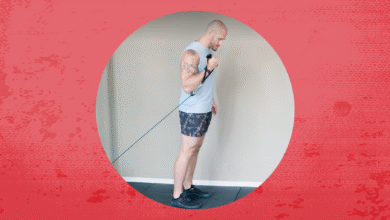The Biggest Exercise Mistake People Make in January

When the new year hits, a switch flips in how so many of us think about fitness: It becomes all exercise, all the time. While strength training sessions, yoga classes, or treadmill jogs may have played just a slight (or…absent) role in lots of people’s day-to-day in the past year, working out begins to jostle for that prime spot as soon as they’re planning out January in their calendars.
And I’m here to tell you: If you want to create a fitness routine that sticks around for the long haul, resisting the urge to go all in when you first start working out can be the best thing you can do to build consistency.
As a certified personal trainer, SELF’s fitness director, and a regular gym-goer for more years than I’d like to count, I’ve seen firsthand what happens when folks go from zero to a hundred in roughly the same amount of time it takes to lace up a new pair of Hokas: Their hour-long workouts, daily Peloton rides, or marathon training runs start to spark anxiety and dread after that initial excitement and adrenaline fizzles. The result? A whole bunch of exercise crammed into one month, maybe two, then little, if any, sprinkled throughout the rest of the year—and the subsequent feeling like they’ve failed at fitness, or that exercise just isn’t for them.
I’m a firm believer that fitness can be for everyone, and that it can play a continual, sustained role in anyone’s life—as long as you find a way to let it complement, rather than take over, your regular routine. Here are some tips that can help you do just that.
Ask yourself how often you want to work out—and then schedule half of that.
A friend of mine used to teach a boot camp class on Mondays, Wednesdays, and Fridays, which I’d attend some days or lift on my own during others. At the beginning of January, each session would be stacked—a whole bunch of people would show up for all of them. Then as time went on, attendance dwindled. One thing we noticed? It was the people who started with a bang that tended to drop completely, while those who showed up for one or two classes per week stayed consistent.
This brings me to my first piece of advice: Purposefully schedule fewer exercise days than you’d like when you’re just getting started, even if you want to go harder. So if you initially think you should plan for a fitness class on Mondays, Wednesdays, and Fridays, start with just Mondays, and do that for an entire month. Then re-evaluate: Ask yourself how it’s feeling with your schedule. Are you looking forward to your workout days? Do you have enough time during the rest of the week to do your grocery shopping, prep your meals, keep up with your relationships, and allow your body and mind to unwind? If so, go ahead and add a second day for the next month, and then regroup again. Still feeling the itch to sign up for that third class—and chill about everything else? Then test out three classes per week for the next month to see how that works for you.
Unfollow social media accounts that make you feel like shit about your plan or progress.
Fitness social media can sometimes do more harm than good for folks dipping their toes into a workout program—you see runners getting up at 5 a.m. to log double-digit miles, CrossFitters repping out loads of pull-ups, and gym-goers deadlifting twice their bodyweights. With each swipe the comparison game bubbles up: If they can do these big, amazing things, why can’t I?!
I think that’s a huge reason new exercisers fall into the too much, too soon trap: They see highlight reels and look at them as the norm, the base that they should be hitting if they want to be a lifter, a runner, a yogi, or whatever. It’s not! Those clips are just showing what that person intentionally wants to put out there, which, in many cases for fitfluencers, is their actual, literal job.
You just can’t compare your fitness journey to what a stranger is pumping out on social media—it’s not apples to apples. And if you find yourself feeling bad about your routine (or how your body looks, the gear you use, the PRs you’ve hit, or whatever it may be) based on what you’re seeing, it’s time to unfollow.
Don’t chase soreness.
Whenever you start a fitness program or switch one up, you’ll inevitably feel sore after you exercise. That’s completely normal: There’s simply more microtrauma to your muscles when they’re put through something they’re not used to. (Don’t worry—these tears will mend, which is how you build muscle and get stronger.)
It’s also completely normal to stop feeling a certain level of soreness as your body adjusts to your workout program. This can be a little jarring. You might start to think you’re not doing enough, or feel like you need to ramp things up to bring back that hurts-so-good feeling. But keep in mind: Soreness is not the marker of a successful workout; you absolutely are getting stronger, improving your endurance, and building muscle without it. In fact, if you want to continue making gains for the long haul, keeping your workout intensity in check so your body feels primed and ready to take on your next session (not so sore you can barely lift your arms) is the better way to go about it.
Prioritize rest as much as your workouts.
Along that same note, you really, really need rest days. Contrary to what some fitness apps that praise exercise streaks may lead you to believe, you don’t get a literal gold star for working out daily. In fact, it’s more likely to bring on burnout, injury, decreased performance, and a plummeting sense of enjoyment when gym time rolls around.
So please, take your rest days. Regular exercisers should shoot for two a week, as SELF reported previously, but if you’re just getting started with fitness, I recommend sandwiching in at least one between every workout day. And I mean actual rest. There’s nothing wrong with taking a day completely off from any kind of formal movement. You don’t have to “fill” your time with active recovery options, like brisk walks, easy bike rides, yoga, or stretching. Embrace the time off from your workout and enjoy all the other stuff you’ve got going on instead. Then when it’s time for your next routine, you’ll feel ready and raring to give it what you’ve got.
Remind yourself that exercise is dynamic.
It’s great that you’re starting with fitness, but remember: It’s not going anywhere! Your gym, yoga studio, track, trail, pool, or indoor cycling bike are all still going to be there for you months (and years) down the road, so you don’t need to cram it all in from the get-go.
To use one of the biggest exercise metaphors out there, it’s a marathon, not a sprint. If you give it all you’ve got when you’re starting out, yes, you’ll burn bright right out of the gate—but then you’ll quickly fade and fizzle. If you ease in and gradually start to ramp up as your body and mind adjust, you’ll have enough juice to continue wherever you want to go, for however long you want to do it.
And this isn’t to say there will never be times when you want to do a sprint instead of a marathon. There will certainly be seasons in your exercise journey when you do want to go all-in (say, a race you’re training for, or a class that runs for only a couple of months), just as there will be times when you’ll need to pull back (busy periods at work, or after an illness that leaves you wiped). Chances are, if you were to log the details of your fitness program every three months for the next five years, it would appear a little different each time. That’s just what happens when exercise becomes part of your life: It ebbs and flows, sure, but when you ease into it sustainably—and find real joy in your movement—it will always be waiting for you when you’re ready for it.
Related:



